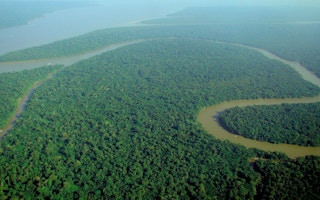The Earth is a huge floating mass of rock, liquid and gas, weighing a staggering 5.9 sextillion tonnes. But there’s only one part that supports life: the biosphere, a thin ribbon that wraps around the planet’s surface, stretching about 20 kilometers (12 miles) from top to bottom.
Modern humans have lived in the biosphere for about 250,000 years, but as populations have expanded and spread globally, our relationship with the biosphere has become troubled. Humans have drastically altered the land and oceans, and contributed to a reduction in populations of other species.
In fact, the current weight of the human population is about 10 times the weight of all wild mammals. Large-scale burning of coal, oil and gas has contributed to a dramatic rise in carbon dioxide levels in the atmosphere. This, in turn, has led to 1.2° Celsius (2.2° Fahrenheit) of warming compared to pre-industrial levels, threatening our ability to thrive in the only place we can call home.
In a new paper in Ambio, published by the Royal Swedish Academy of Science in the leadup to the upcoming “Our Planet, Our Future” Nobel Prize Summit, a team of international scientists provides an overview of humanity’s volatile relationship with the planet, but also discusses ways in which global sustainability can still be achieved. One of the key points in the report is that humans need to think of ourselves as embedded in the biosphere, rather than being separate from it, and that any societal changes need to bear this in mind.
“The biosphere is not just [made up of] other organisms — it’s us as well, as part of the living dimension of Earth,” lead author Carl Folke, a world-renowned environmental scientist at the Stockholm Resilience Centre, told Mongabay in an interview. “And I think it’s important to really make clear that the living organisms are not just existing in the framework of the Earth system, but are also shaping it.”
The report discusses the importance of living within the Earth’s nine planetary boundaries — that is, system processes that are essential in regulating the stability and resilience of the planet, but have limits up to which they can tolerate changes due to human activities. These boundaries are identified as climate change, biosphere integrity, ocean acidification, depletion of the ozone layer, atmospheric aerosol pollution, biogeochemical flows of nitrogen and phosphorus, freshwater use, land-system change, and the release of novel chemicals such as heavy metals and plastics.
The Earth has been largely resilient to the demands that humans have placed on it, but this is no longer the case, the paper says. Mounting pressure on the Earth’s vital systems may push the world into a new, unknown state that isn’t quite as hospitable to human life. Four of the planetary boundaries may have already been breached, including climate change and biosphere integrity, which are also considered to be “core” boundaries due to their fundamental importance in regulating the Earth.
The report also highlights rising inequality, which can lead to rapid environmental degradation and undermine the ability of societies to work toward sustainability. With this in mind, the paper says inequity needs to be addressed as an essential part of global sustainability efforts.
“It’s very difficult to make long-term decisions in a very unequal society where there’s a lack of trust in the decision-makers [where people] feel that decision-makers are pandering to the elites,” co-author Owen Gaffney, a global sustainability analyst at the Stockholm Resilience Centre, told Mongabay in an interview. “So actually reducing inequality will help make long-term decisions on things like climate change, biodiversity loss.”
While the issues facing our planet are formidable, demanding urgent and large-scale action to remedy, the paper suggests that solutions are at hand. The key, according to the authors, lies in transformative change: sweeping, fundamental revisions that can help restructure society and our relationship with the world.
Social innovations, broad shifts in cultural repertoires, different approaches to biosphere stewardship, and emerging technologies can all play a role in this transformation, according to the report. However, it also warns that technology alone cannot do all the work in achieving sustainability.
“Of course it’s overwhelming … but there are ways out of it,” Folke says. “That’s the hopeful thing. I don’t really believe in just talking about the crisis and the doomsday [scenario]. I think that’s not the way to go, but really instead looking into the opportunities for … transformation.”
Folke says he sees evidence of transformation already as a growing number of countries commit to net-zero carbon emissions by 2050, businesses work to phase out greenhouse gas emissions, and interest grows in nature-based solutions.
“We have written this paper to try to … begin guiding the navigation towards sustainable futures, because that’s the only way forward, actually, if we want to be able to be 9 to 10 billion people [living] healthy, good, good lives, both in terms of food, water and material foundations.”
The “Our Planet, Our Future” Nobel Prize Summit, which will be the first of its kind, will take place online between April 26 and 28, and is open to all people to attend. It will feature Nobel laureates such as Tibetan spiritual leader the Dalai Lama and former US vice president Al Gore, as well as other prominent experts and figures.
The summit will explore what can be learned from the global pandemic to reduce the risk of similar events in the future, and what actions can be taken in this decade to move the world onto a more sustainable path.
“I think it’s really important that the scientific community comes together and makes a strong statement on what is needed,” Gaffney said. “It’s not just about climate change, it’s not just about emissions reductions — it’s about a whole system’s approach to our planet, to our biosphere.
“We have a responsibility to articulate the science as clearly as possible and highlight the emergency situation we’re in.”
This story was published with permission from Mongabay.com.










